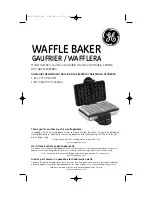
- 38 -
Useful information about
ingredients
FLOUR
Most of the commercially available varieties of
flour, such as wheat or rye flour, are suitable for
baking. The type designation for flour types may
vary from country to country. With the baking
program "gluten-free", gluten-free flour types such as
corn, buckwheat or potato flour can be used. You
can also use ready-to-use baking mixtures.
Programmes 1 and 2 are ideal for adding small
proportions (10-20%) of grains or groats.
In case of larger proportions of whole grain
(70-95%) use programme 3.
YEAST
In the fermentation process, yeast splits the sugar and
carbohydrate contained in the dough and converts
them into carbon dioxide, which causes the dough
to rise. Yeast is available in different forms: as dry
yeast, as fresh yeast or as fast fermenting yeast.
We recommend using dry yeast for the bread
maker to obtain the best results.
If you are using fresh yeast instead of dry yeast,
observe the instructions given on the packaging.
In general, 1 packet of dry yeast corresponds to
about 21 g of fresh yeast and is suitable for
approx. 500 g of flour. Always store yeast in the
refrigerator, as heat decomposes it. Before use,
check the expiry date. After opening the package,
unused yeast should be carefully wound up and
stored in the re-frigerator.
Note:
For recipes suggested in this recipe book, we
recommend the use of dry yeast.
SUGAR
Sugar has a decisive influence on both the degree
of browning and the taste of the bread. The use of
crystal sugar is assumed for the recipes in this
book. Do not use powdered sugar, unless it is
expressly specified. Sweeteners are not suitable as
alternatives to sugar.
SALT
Salt is important for the taste as well as the degree
of browning. Salt also has an inhibiting effect on
yeast fermentation. Therefore, do not exceed the
quantity of salt specified in the recipes. Salt can be
dispensed with for dietary reason. In such cases,
the dough may rise faster than usual.
LIQUIDS
Liquids like milk, water or reconstituted milk powder
can be used for making bread. Milk adds to the taste
of the bread and softens the crust, whereas pure
water gives a crispy crust. In some recipes, the use
of fruit juices is indicated in order to give a particular
flavour to the bread.
EGGS
Eggs enrich the bread and give it a softer structure.
Use eggs of the largest size class when baking the
recipes given in this recipe book.
RH_KH1171_E40536_UK.qxd 06.10.2009 9:30 Uhr Seite 38
Содержание KH 1171
Страница 2: ...햲 햳 햴 햵 햶 햷 쐎 쐅 햲 햳 햴 햵 햶 햷 쐎 쐅 CV_KH1171_38170_LB5 12 10 2009 15 55 Uhr Seite 5 ...
Страница 20: ... 18 ...
Страница 38: ... 36 ...
Страница 56: ... 54 ...
Страница 74: ... 72 ...
Страница 92: ... 90 ...
















































